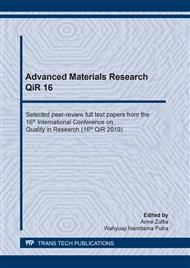[1]
M. Saini, Implant biomaterials: A comprehensive review, World J. Clin. Cases, (2015).
Google Scholar
[2]
D. R. Sumner, Long-term implant fixation and stress-shielding in total hip replacement, J. Biomech., (2015).
Google Scholar
[3]
M. A. Papadopoulos and F. Tarawneh, The use of miniscrew implants for temporary skeletal anchorage in orthodontics: A comprehensive review, Oral Surgery, Oral Med. Oral Pathol. Oral Radiol. Endodontology, (2007).
DOI: 10.1016/j.tripleo.2006.11.022
Google Scholar
[4]
Y. F. Zheng, X. N. Gu, and F. Witte, Biodegradable metals, Mater. Sci. Eng. R Reports, vol. 77, p.1–34, Mar. (2014).
Google Scholar
[5]
H. S. Brar, M. O. Platt, M. Sarntinoranont, P. I. Martin, and M. V. Manuel, Magnesium as a biodegradable and bioabsorbable material for medical implants, JOM, (2009).
DOI: 10.1007/s11837-009-0129-0
Google Scholar
[6]
C. J. Boehlert and K. Knittel, The microstructure, tensile properties, and creep behavior of Mg–Zn alloys containing 0–4.4 wt.% Zn, Mater. Sci. Eng. A, vol. 417, no. 1–2, p.315–321, Feb. (2006).
DOI: 10.1016/j.msea.2005.11.006
Google Scholar
[7]
S. Cai, T. Lei, N. Li, and F. Feng, Effects of Zn on microstructure, mechanical properties and corrosion behavior of Mg–Zn alloys, Mater. Sci. Eng. C, vol. 32, no. 8, p.2570–2577, Dec. (2012).
DOI: 10.1016/j.msec.2012.07.042
Google Scholar
[8]
P. Ghosh, M. Mezbahul-Islam, and M. Medraj, Critical assessment and thermodynamic modeling of Mg–Zn, Mg–Sn, Sn–Zn and Mg–Sn–Zn systems, Calphad, vol. 36, p.28–43, Mar. (2012).
DOI: 10.1016/j.calphad.2011.10.007
Google Scholar
[9]
E. Zhang, D. Yin, L. Xu, L. Yang, and K. Yang, Microstructure, mechanical and corrosion properties and biocompatibility of Mg–Zn–Mn alloys for biomedical application, Mater. Sci. Eng. C, vol. 29, no. 3, p.987–993, Apr. (2009).
DOI: 10.1016/j.msec.2008.08.024
Google Scholar
[10]
Y. Jingyuan, W. Jianzhong, L. Qiang, S. Jian, C. Jianming, and S. Xudong, Effect of Zn on Microstructures and Properties of Mg-Zn Alloys Prepared by Powder Metallurgy Method, Rare Met. Mater. Eng., vol. 45, no. 11, p.2757–2762, Nov. (2016).
DOI: 10.1016/s1875-5372(17)30035-8
Google Scholar
[11]
H. Wei et al., Towards strong and stiff carbon nanotube-reinforced high-strength aluminum alloy composites through a microlaminated architecture design, Scr. Mater., vol. 75, p.30–33, Mar. (2014).
DOI: 10.1016/j.scriptamat.2013.11.014
Google Scholar
[12]
S. J. Yoo, S. H. Han, and W. J. Kim, Strength and strain hardening of aluminum matrix composites with randomly dispersed nanometer-length fragmented carbon nanotubes, Scr. Mater., vol. 68, no. 9, p.711–714, May (2013).
DOI: 10.1016/j.scriptamat.2013.01.013
Google Scholar
[13]
S. Li, B. Sun, H. Imai, and K. Kondoh, Powder metallurgy Ti–TiC metal matrix composites prepared by in situ reactive processing of Ti-VGCFs system, Carbon N. Y., vol. 61, p.216–228, Sep. (2013).
DOI: 10.1016/j.carbon.2013.04.088
Google Scholar
[14]
B. Chen et al., Load transfer strengthening in carbon nanotubes reinforced metal matrix composites via in-situ tensile tests, Compos. Sci. Technol., vol. 113, p.1–8, Jun. (2015).
DOI: 10.1016/j.compscitech.2015.03.009
Google Scholar
[15]
Y. Wang, M. Wei, J. Gao, J. Hu, and Y. Zhang, Corrosion process of pure magnesium in simulated body fluid, Mater. Lett., (2008).
Google Scholar
[16]
W. D. Müller, M. L. Nascimento, M. Zeddies, M. Córsico, L. M. Gassa, and M. A. F. L. de Mele, Magnesium and its alloys as degradable biomaterials: corrosion studies using potentiodynamic and EIS electrochemical techniques, Mater. Res., (2007).
DOI: 10.1590/s1516-14392007000100003
Google Scholar
[17]
Z. Shi, M. Liu, and A. Atrens, Measurement of the corrosion rate of magnesium alloys using Tafel extrapolation, Corros. Sci., (2010).
DOI: 10.1016/j.corsci.2009.10.016
Google Scholar
[18]
G. Song, A. Atrens, and D. Suohn, An Hydrogen Evolution Method for the Estimation of the Corrosion Rate of Magnesium Alloys, in Essential Readings in Magnesium Technology, (2014).
DOI: 10.1002/9781118859803.ch90
Google Scholar
[19]
M. Esmaily et al., Fundamentals and advances in magnesium alloy corrosion," Prog. Mater. Sci., vol. 89, p.92–193, Aug. (2017).
Google Scholar
[20]
N. N. Aung, W. Zhou, C. S. Goh, S. M. L. Nai, and J. Wei, Effect of carbon nanotubes on corrosion of Mg–CNT composites, Corros. Sci., vol. 52, no. 5, p.1551–1553, May (2010).
DOI: 10.1016/j.corsci.2010.02.025
Google Scholar
[21]
H. Kalb, A. Rzany, and B. Hensel, Impact of microgalvanic corrosion on the degradation morphology of WE43 and pure magnesium under exposure to simulated body fluid, Corros. Sci., (2012).
DOI: 10.1016/j.corsci.2011.12.026
Google Scholar



